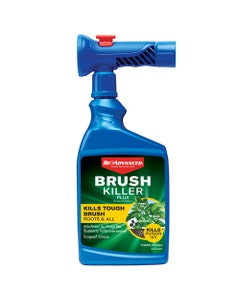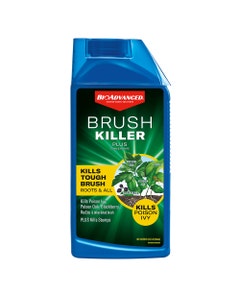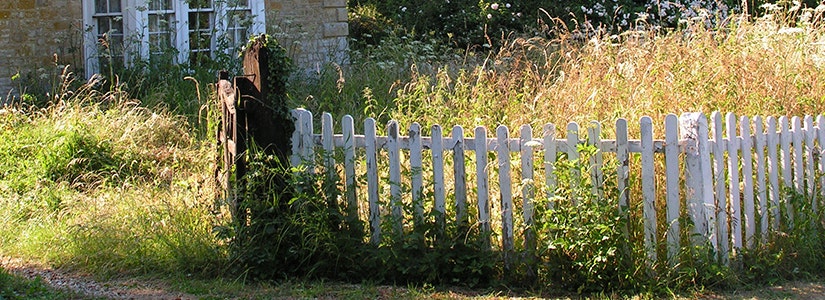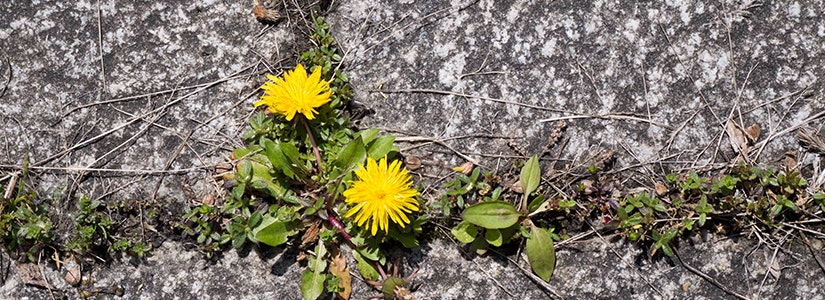

- Home
- Solution Center
- Learn
- Lawn and Landscape
- 6 Aggressive Brushy Weeds
6 Aggressive Brushy Weeds
Some brushy weeds plague properties from coast to coast. Others present more regionalized problems. Whether you battle Poison Ivy, Kudzu, Wild Blackberry, or another aggressive plant, here are some helpful tips to help you win the battle with brush.

Poison Ivy (Toxicodendron radicans) (shown) and Poison Oak (Toxicodendron diversilobum)
Most famous for their rash-inducing qualities, Poison Ivy and Poison Oak are two brushy weeds to handle with care. Wear long sleeves, pants, boots and gloves when treating plants. A herbicide can kill plants at the root; follow label directions carefully. Never burn these poisonous plants, as soot particles carry the rash-producing allergen and can cause life-threatening reactions internally.
Size: 3-30 feet high or more and 3-40 feet wide; plant size and appearance vary depending on region
Hardiness: Zones 3-11
Preferred habitat: Sun to part shade; frequently found along the edge of woods, climbing and clinging to tree trunks, in meadows and ditches
Similar brushy weeds you should treat like Poison Ivy: Poison Sumac

Wild Blackberry (Rubus fruticosus)
Thorny, fruit-producing stems quickly scramble over existing vegetation to establish a prickly barrier. Fruit attracts wildlife, including undesirables like rats and tick-carrying mice. Stems root where they touch soil, and plants also sprout from underground stems. Mowing triggers branching and additional shoot formation, while tilling breaks roots into multiple pieces that sprout. Using herbicides followed by mowing, tilling or digging can eventually control plants.
Size: 24-60 inches high and wide per plant, although single plants can form large colonies up to 9 feet across
Hardiness: Zones 3-10
Preferred habitat: Sun to part shade; frequently thrives along fence rows, the edge of woods, clearings and ditches
Similar brushy weeds you should treat like Wild Blackberry: Raspberry, Salmonberry

Canada Thistle (Cirsium arvense)
Also called Spreading Thistle, this prickly plant sprouts from seeds and roots. A one-quarter-inch-long piece of root contains enough food reserves to support a new plant for at least 100 days. Tilling breaks roots into smaller pieces that sprout. To beat this weed, you want to deplete food stores in roots that support stem growth. Combine herbicide sprays with mechanical controls such as mowing at one-month intervals over several growing seasons.
Size: 24-72 inches high and 15-18 inches wide; roots spread 15 feet wide or more and up to 15 feet deep
Hardiness: Zones 3-11
Preferred habitat: Full sun; disturbed soil, pastures, ditches and waste areas
Similar brushy weeds you should treat like Canada Thistle: Curly Dock, Burdock, Common Teasel. These weeds don't sprout from roots but do produce deep taproots. Control using a combination of herbicides and/or tilling and mowing.

Trumpet Vine (Campsis radicans)
Many gardeners love the orange blossoms of Trumpet Vine because they beckon hummingbirds. But this beauty can quickly smother desirable plants. Like Canada Thistle, Trumpet Vine produces an extensive root system capable of sprouting new plants. This vine also roots along its length where stems touch soil. Effective control may take several growing seasons. Combine herbicide treatments with cutting back vines.
Size: 25-40 feet high and 5-10 feet wide
Hardiness: Zones 4-10
Preferred habitat: Full sun to part shade in average soils; vines scramble along fence rows, up telephone poles or quickly provide ground cover
Similar brushy weeds you should treat like Trumpet Vine: Virginia Creeper, Wild Grape

Black Locust (Robinia pseudoacacia)
Originally planted as a wood source for fence posts, Black Locust produces shoots from its extensive root system, quickly forming dense clumps. Mowing or brush hogging causes more shoots to emerge from roots. To control, combine herbicide applications with cutting. Herbicides can be used on foliage (on small trees), applied to the tree trunk base or painted on cut stumps.
Size: 20-50 feet high and 20-35 feet wide
Hardiness: Zones 3-10
Preferred habitat: Full sun; grows in a variety of soils, including disturbed soils and waste areas, as well as meadows, hillsides, pastures or mountainsides
Similar brushy weeds you should treat like Black Locust: Hawthorn, White Poplar, Elderberry

Kudzu (Pueraria montana)
This climbing, semi-woody perennial vine grows at a rapid pace (up to 1 foot per day), covering anything in its path, including desirable plants. Kudzu spreads by runners – vines that root upon touching soil – underground stems and seeds. Mowing young plants repeatedly over three to four years can kill vines. For mature vines, removing up to 80 percent of foliage per season for three to four years can starve roots. When using an herbicide, spray as many climbing vines as possible; cut stems that don't respond to treatment. You can also use grazing to remove vines. Use eight goats per acre. Replant cleared areas as soon as possible to prevent kudzu from re-establishing.
Size: 35-100 feet in length; roots can spread 6 feet or more
Hardiness: Zones 5-10; frosts and freezes won't kill vines 2.5 inches or larger in diameter
Preferred habitat: Full sun; grows in a variety of soils, but thrives in eroded or sandy soil; also can survive in well-drained, acidic soil in forests
Similar brushy weeds you should treat like Kudzu: Honeysuckle, Bindweed, Scotch Broom
Having problems with weeds and brush? Check out BioAdvanced™ Brush Killer Plus. Be sure to contact your local Cooperative Extension System office for best timing for your region.














